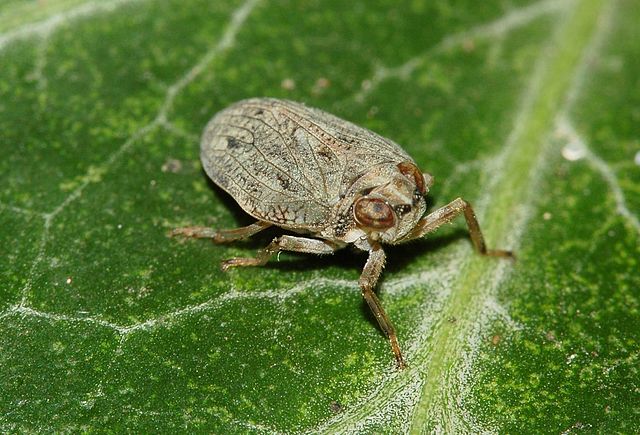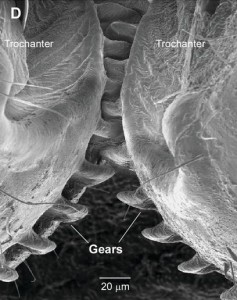Gears in Nature
Subject areas: Entomology, Developmental Biology
Vocabulary:
Trochanter – the part of the femur (upper leg bone) that connects to the hip.
Coxa – hip joint
nymph stage – In the metamorphosis of insects most people are familiar with (e.g. butterflies), there is a significant change in form from the larval stage to a pupa or chrysalis, and finally adult. However, some insects, like grasshoppers and planthoppers, undergo what is called hemimetabolous metamorphosis, and instead of a distinct pupal phase, they go through a series of nymph stages, molting several times to increase in size and gain various adult structures until the final molt forms the adult.
The article:
Burrows, M. and Sutton, G. Propulsive leg movements in a jumping insect. Science 341:1254-1256 (2013). doi: 10.1126/science.1240284
Think about toothed gears. Many of us would think of the many gears inside mechanical watches and clocks. Maybe giant gears in the heavy machinery depicted in countless action movies where the protagonist dodges in and out of the machinery to take shots at his pursuer. Almost none of us would think of a live animal when asked to think about gears, but here Burrows and Sutton demonstrate not just gear-shaped parts, but actual working gears in a hopping insect.
Background
Planthoppers are a superfamily (Fulgoroidea) of insects that are found worldwide. They are named because they have the ability to leap great distances (relative to body size), although unlike grasshoppers, which are in a different order, they appear to use walking as their primary means of locomotion, with hopping used less frequently, perhaps as a means of escape. When these planthoppers do hop, they generate a huge amount of force: as much as 719 g, though more typically 200-300 g (here g does not refer to grams, but multiples of gravitational force, or g-force).
The complication of generating that much force on a relatively small mass is that it needs to be very precisely applied or the insect will go spinning out of control. It is sort of like flicking a small toy car across the floor. If you flick the back of the car, right in the middle of the two sides, it will probably roll pretty straight. However, if you are off-center and flick the car slightly to one side or the other, the car will probably spin out of control. In that case, the precision application has to do with positioning. In the case of the planthopper, the precision comes in timing: both legs need to kick out at the same time. Using our car analogy again, this time lets say we flick the car forward with two fingers – one from each hand, each squarely in line with either the right wheels or the left wheels. If we time it right, the car goes forward. If we time it wrong, the car spins out of control. If you try this as a classroom experiment, you might also note that the effect is diminished with lighter flicks, and magnified by stronger flicks.
What They Did
Burrows and Sutton decided to use high-speed video capture to examine how the insects were able to synchronize their hind-legs. In these videos, they found that the hindlegs would start moving within 30 microseconds (millionths of a second) of each other. They realized that was too fast for coordination by the nervous system of the planthopper, whose signals are in the range of milliseconds (thousandths of a second) in length.
Examining the hoppers, they found that the young nymph forms of the hoppers had gears built into the trochanter of each leg, and the gears engaged one another so that movement of one leg also moved the other. So here was evidence that there was a physical gear mechanism for synchronization of the legs. The next step was to show that they were actually used as gears in jumping. A few other animals have gear-shaped parts, but none have been shown to be used as interacting mechanical gears.
To check for their involvement in hopping, the planthoppers were turned on their backs so that the video camera could capture the movement of the legs. What they found was that the gears on each trochanter did in fact engage in preparation for a jump, as well as during the jump movement. So to sum up, they figured out that the nervous system was insufficient for the level of synchrony that they saw in their initial observations. They found a mechanical linkage that could potentially provide that synchronization. Finally, they showed that the gears were actually used in the process of jumping.
Just for Kids
Interestingly, these gears are only found on the juvenile, nymph, stages of the planthoppers. The adults do not have the gears. They have not yet tried to answer why, but the researchers suggest that perhaps the adults have a different, more sensitive mechanism for synchronization based on the friction of their larger legs on the coxa. It is possible that the gears are a kind of “training wheels” for the juvenile forms, possibly because they are either unable to sense or interpret the friction of the legs like the adults do.




No comments
Be the first one to leave a comment.